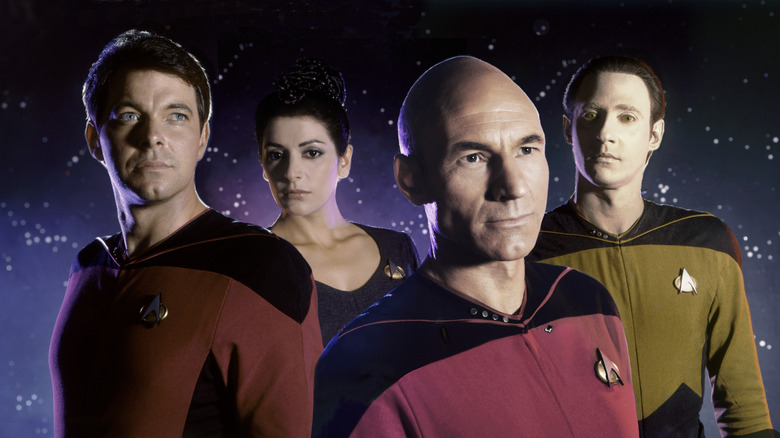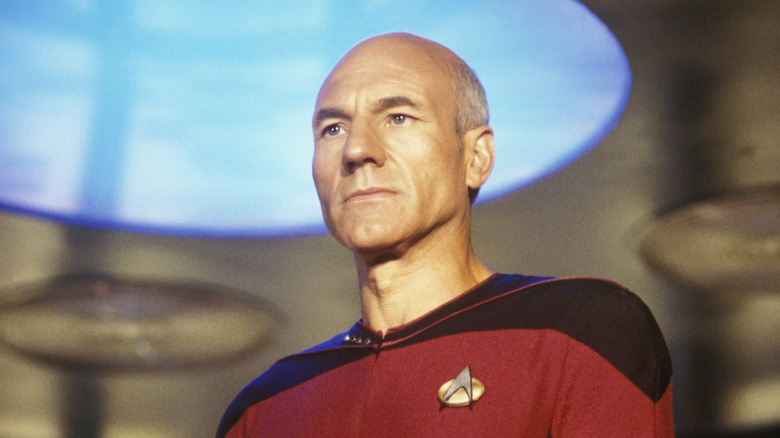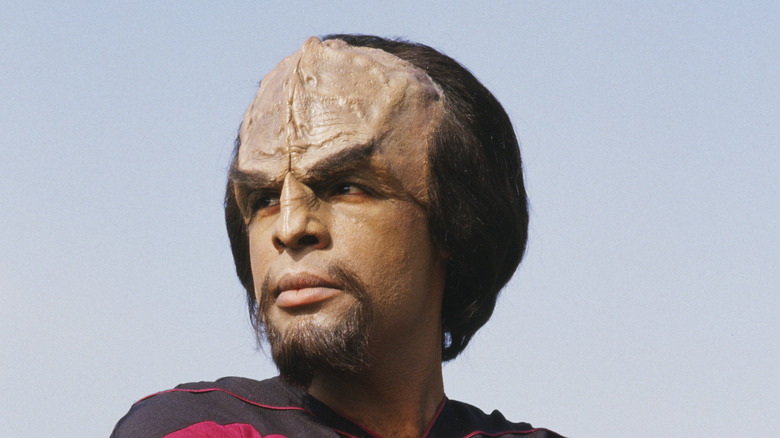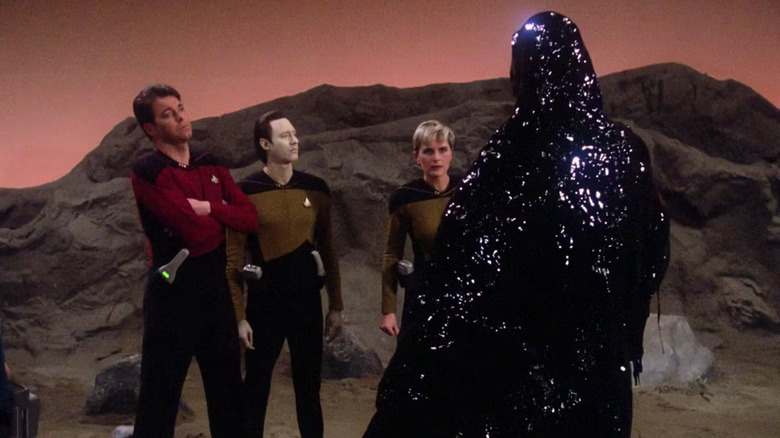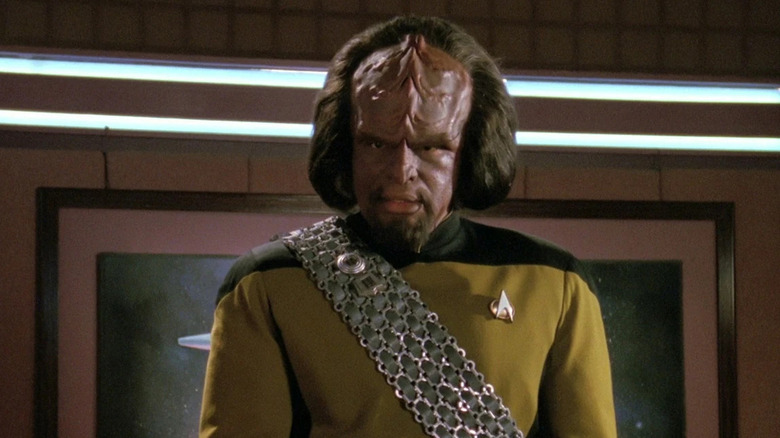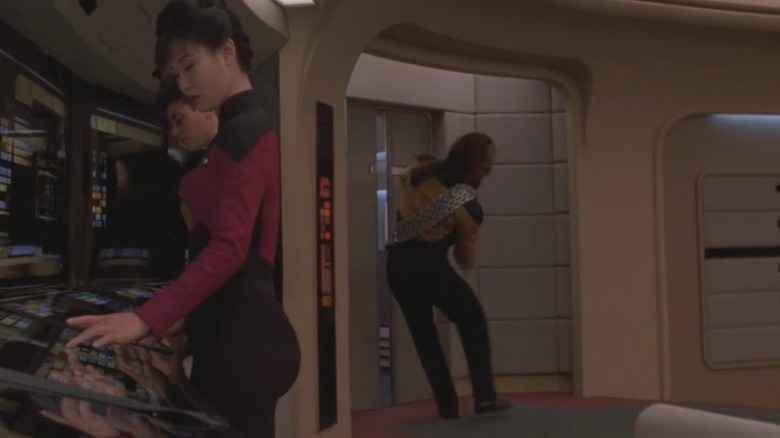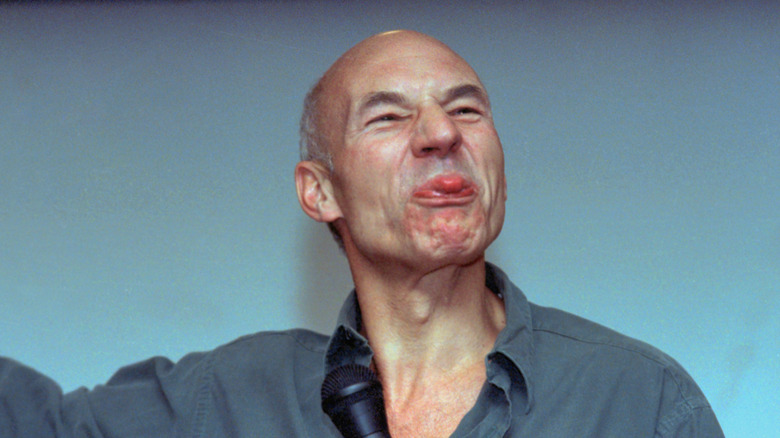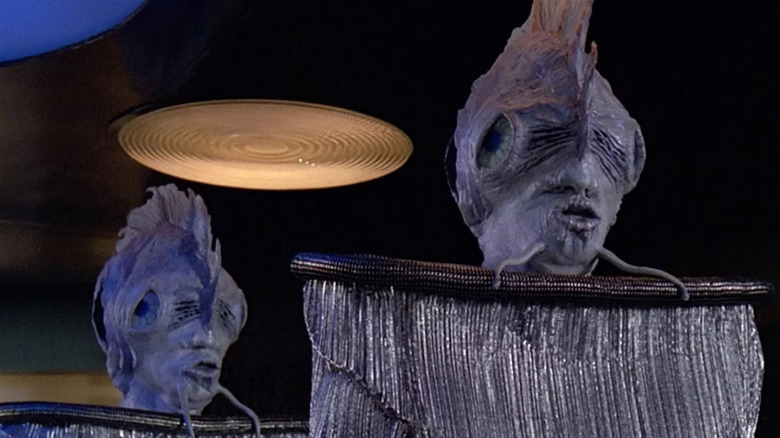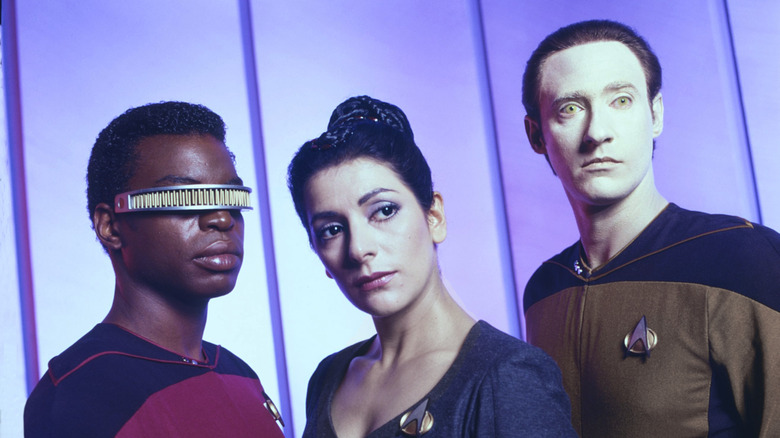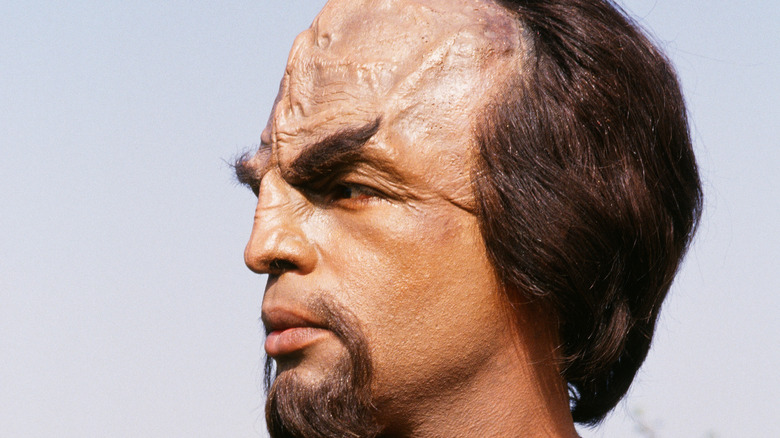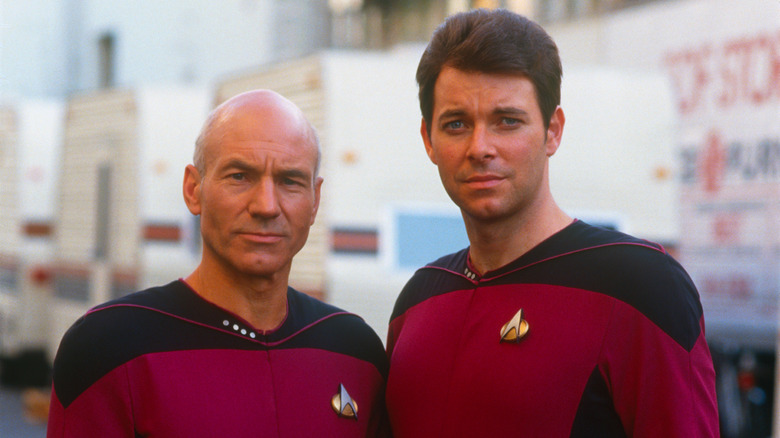Bizarre Things That Happened On The Set Of Star Trek: The Next Generation
Let's be honest: few fans of "Star Trek" are really going to take things all that seriously. Sure, you may have an overcommitted devotee or two making a scene at a fan convention, but Trekkies are far more likely to understand that their beloved show has a pretty goofy side to go along with the starry-eyed philosophizing. This is, after all, a collection of movies and television series that includes silly alien costumes, at least one potentially deadly attempt at a Vulcan wedding ceremony, a couple of wisecracking bartenders, and the occasional pile of tribbles growing at an alarming rate.
But, surely, if there were a serious cast and crew, it would be the group that made "Star Trek: The Next Generation," widely regarded as the best-ranked series of the many-armed franchise. Airing for seven seasons from 1987 to 1994, the series took on heady topics like the nature of intelligence, making first contact with new species, and interplanetary war. Plus, it was headed by Captain Jean-Luc Picard, whose noble affect and stentorian voice were provided by Shakespearean actor Patrick Stewart, who turned Picard into something of a spacefaring philosopher king.
Yet, interviews, memoirs, and fan convention appearances make it clear that it wasn't all buttoned-up seriousness on set. The making of "Star Trek: The Next Generation" also includes some seriously silly antics and a few bizarre occurrences, making it clear that the weirdness wasn't restricted to bizarre things that happened on the set of the "Star Trek" original series.
Patrick Stewart had an embarrassing temper tantrum
Going into the first shoots for "Star Trek: The Next Generation" was assuredly strange for Patrick Stewart. Before joining the new series ahead of its 1987 premiere, he'd been a serious stage actor. As in, a highly-regarded member of the National Theatre and the Royal Shakespeare Company sort of serious. In his pre-"Star Trek" career, Stewart had gotten used to highly focused work environments.
His entry into TV work, then, was pretty jarring. In his memoir, "Making It So," Stewart recalled that the informal, seemingly time-wasting antics of his new co-stars so rankled him that he called a meeting of the cast. But when he began to upbraid them, Denise Crosby (who played security chief Tasha Yar in the first season) said, "We've got to have some fun sometimes, Patrick." Stewart retorted, "We are not here, Denise, to have fun." Everyone laughed.
Stewart now acknowledges that he was being a serious wet blanket and that this anecdote about his seemingly allergic reaction to fun is itself pretty funny. But the Patrick Stewart of 1987 took this all pretty poorly. He recalls that, in the face of his colleagues' laughter, he fled to his trailer and sulked there. Finally, co-stars Jonathan Frakes and Brent Spiner knocked on his door and gently talked their new show lead down. Even then, chilling out took some doing, as Stewart admitted it took most of that first season for him to shed much of his straight-laced demeanor.
Someone may have stolen Worf's prosthetic forehead
Through the long history of "Star Trek," the Klingon forehead has been a particularly thorny problem. In their first appearances in the original series of the 1960s, they had noticeably smooth domes that did little to distinguish them as aliens and later pointed to a messed-up truth about Star Trek's Klingons. By the time they started popping up as antagonists in the feature films starring Captain Kirk and crew, a dramatic change had occurred. Klingons now sported dramatically ridged foreheads and more complex costumes. The real-world explanation was that production designers and makeup artists simply had a bigger budget with the films. That stylistic change carried through into the 1980s, when the glowering (if relatively more friendly) Lieutenant Worf made his appearance on "Star Trek: The Next Generation."
But, look carefully, and you'll notice yet another Klingon forehead transformation between Season 1 and Season 2 of "The Next Generation." First-season Worf has — if any Klingons are reading, please excuse the rudeness — kind of a smooth forehead. It's nothing like the Klingons from the original series, but from the second season onwards, his forehead ridges were far more defined. The behind-the-scenes explanation is that, between these seasons, the facial prosthetics applied to actor Michael Dorn went missing. Or, as some have alleged, it could be that a mysterious thief purloined them for some odd, unknown reason. Maybe the missing forehead is still out there somewhere, secreted in someone's desk drawer or attic box.
One episode had crew managing actors covered in black slime
Of the first season of "Star Trek: The Next Generation," one of the most notorious episodes is "Skin of Evil," when Security Chief Tasha Yar is abruptly murdered by a slime-covered being. Actor Denise Crosby was reportedly daunted by the prospect of years standing around in a Starfleet uniform, repeating the same lines in slightly different forms. Yar did return to "Star Trek: The Next Generation" in a couple of different forms in following seasons, including one of the best episodes according to IMDb, the time travel favorite "Yesterday's Enterprise." thankfully none involved the viscous black goo dripping off Yar's killer, Armus.
In "Skin of Evil," the black goo was an especially gross fact of production. According to actor Jonathan Frakes — who had to go in the goo himself — when he asked the show's prop master just what was in the glop, he was told it was a mixture of Metamucil and black ink (via "Star Trek: The Next Generation 365"). While Marina Sirtis has used this incident as an example par excellence of how Frakes was up for pretty much everything, the real endurance test was for stunt performer Mart McChesney. He spent four days in a cumbersome suit, covered in the goo, to play Armus. Indeed, though the glop was reportedly non-toxic, it proved to be a massive mess, to the point where the crew set up a hose to routinely rinse themselves of the stuff.
Michael Dorn routinely pretended to assassinate Patrick Stewart
With long hours and repetitive shoots that could go on well past typical working hours, it was clear that the cast of "Star Trek" would have to make their own fun when they were — let's be honest here — stuck together on the set of "The Next Generation." Sometimes, it was an easy fix of flubbed lines and silly voices, to be sure. At other times, it may well have involved relaxing a bit in trailers or dressing rooms. And on a few regular occasions, at least where Michael Dorn was involved, it could revolve around some light attempts at assassination (all in good fun, of course).
Okay, the actor who played Worf wasn't actually trying to kill anyone. And, by many accounts, Dorn was actually a happy, even relatively sweet-tempered co-worker ("Star Trek" co-star Marina Sirtis even told Buzzfeed that she considers him to be an especially close friend, though she said they initially hated each other that very first season). But the pressures of a repetitive and winding shoot can get to anyone. By Dorn's own admission at a fan convention, he occasionally attempted to lighten things up by dramatically narrating his plans to take down Patrick Stewart with whatever was at hand. This could be something as seemingly innocuous as a banana, assuming it was close by, though the tragic and unexpected end of the starship captain was always the end result of Dorn's playacting.
Doors on set were very definitely not automatic
Today, even relatively casual fans of "Star Trek" are likely aware that the futuristic automatic doors were anything but in the original series. During production, the whooshing doors were actually manually operated by out of sight stagehands operating a series of decidedly old-school pulleys. In the world of the series, the doors only seem to operate when a person seriously intends to go through them (consider how many times Kirk or Picard linger near a door jabbering on about their problems without the passageway opening). Back in the real world, this meant that said stagehands had to be pretty on top of the script and the actors' movements.
However, this proved troublesome not only on the original series, but "Star Trek: The Next Generation." Here, too, it seems reasonable to conclude that some poor, mis-timed stage hand had a dressing-down or two over the matter of their timing. Moreover, actors were apparently instructed to stride towards doors with purpose and very little intent of slowing down should something go awry. This has resulted in a series of door-related bloopers across the "Star Trek" series and movies. A few involve Michael Dorn boldly walking towards an exit and then face-planting into the inexorably closed doors (and perhaps needing a touchup to his rather complicated and now presumably squished Klingon makeup afterward). Even on the show as it was aired, Worf seems to have had particular trouble with doors failing to operate as expected.
Tired actors razzed new directors in odd ways
If the glamor of acting has long drawn your attention, then it's time for a reality check: being a working actor, especially on a busy series, can be both exhausting and intensely boring. Sure, we may enjoy the fan convention stories Michael Dorn and Brent Spiner have told about repeatedly goofing off while filming a scene. However, it's clear that time-consuming stunts like this required multiple takes (and weren't exactly amusing to that particular episode's relatively early-career director ... Patrick Stewart).
But even when everyone was on top of things, working on the "Star Trek" set could be tiresome. Talking to CBS Sunday Morning, Patrick Stewart recalled that his early years on the show were so utterly time-consuming that he had practically no social life. Of course, it's easy to understand this upon learning he had a five-day workweek that could include 12- to 15-hour days (some of which meant rolling into the shoot for the next episode almost immediately). Joking was essential to getting through it, and sometimes newbies were easy targets.
As Stewart told the Nerdist podcast (now ID10T with Chris Hardwick) in 2015, "In the later seasons, we had a lot of new directors; I guess the old ones were sick of us." Stewart recalled that he would sometimes complain when asked to do something as simple as stand up after lunch. "Here's another one who hasn't been told," he would say. "I don't do standing-up acting after lunch."
Mick Fleetwood had an oddly hard time with his Star Trek cameo
Surely many "Star Trek" fans can recall getting sweaty palms or a bit of a shake in their voice when they meet a favorite actor. But if they were asked to take part in the filming of an actual episode? That may lead to even more embarrassing stumbles.
Just ask Mick Fleetwood. Yes, that Mick Fleetwood, of the legendary rock band Fleetwood Mac. He's also a serious "Star Trek" fan. As in, serious enough to shave off his beard so he could take on one of weirdest "Star Trek" cameos and play a goofy-looking fish alien (more properly known as a member of the Antedian species), as he told the Vancouver Sun. But he apparently had quite the nerves on set, as he continually flubbed his single line — "food" — as Brent Spiner noted during a fan convention appearance. Fleetwood told the Vancouver Sun that Patrick Stewart was a very generous presence on a set where Fleetwood said "I was basically an idiot, trying to do what I was doing."
Other fans have fared better on the series. Whoopi Goldberg, who joined "Star Trek: The Next Generation" in its second season as Guinan the bartender, once told co-star Patrick Stewart that she was a long-time fan of the show. Given that Guinan returned to the show multiple times and even popped up on the sequel series "Star Trek: Picard," any nerves suffered by Goldberg weren't so bad.
Actor pranks on each other could get weird
Beyond the standard flubbed lines and silly voices meant to lighten the load, there are a few odder pranks that cast members have recalled over the years. One of the first, as Patrick Stewart recounted in "Making It So," related back to a rather unusual write-up he got in the early days of "The Next Generation." In a cast line-up published in the Los Angeles Times, Stewart was referred to as an "unknown British Shakespearean actor." He claims that he wasn't so bothered by the quasi-snub, but castmate Brent Spiner, who played the android Data, took it a step further. He created a sign that he taped to the door of Stewart's trailer that read: "Beware: Unknown British Shakespearean Actor." Though he may have been a bit sour at first about on-set antics, this joke was delightfully odd enough that Stewart says that he has the sign in his possession decades later.
Those long shooting hours also led to some punchy on-set antics. Michael Dorn, stuck in his prosthetic Klingon makeup for hours because he was often a fixture of the Enterprise bridge, seemed to be a particular target because he was the most ready to laugh and break his stern character. Towards the end of the week, Stewart wrote that it became something of a contest to make him laugh hard enough that his false mustache would peel off, leaving Dorn to try and slap it back on amidst increasing giggles.
Worf's character became shorthand for particularly bad filming days
Worf is hardly the cuddliest character. Even casual viewers of "Star Trek: The Next Generation" will soon pick up on the fact that he's the emotional equivalent of a cactus. It's understandable, given that his backstory includes surviving a massacre and undergoing not inconsiderable trauma as an adoptee (which makes his career as the first Klingon in Starfleet all the more impressive). Oh, and it probably doesn't help that actor Jonathan Frakes, who played the at turns admirable and smarmy Commander Riker, nicknamed Worf "Turtlehead" for the distinctive forehead prosthetics sported by an in-makeup Michael Dorn.
From a storytelling perspective, Worf is a rich character. From the point of view of a "Star Trek" set, he's a byword for trouble. At least, that's according to "The Next Generation" cast and crew. While Dorn was described in glowing terms by Patrick Stewart in the latter's memoir, "Making it So," his Klingon character was far less warm and fuzzy. In fact, the notoriously hot-tempered Worf was often connected to cantankerous days on set. If someone just could not shake their bad mood or things were starting to come apart at the seams in some other way, Stewart says that they would describe it as entering "Worfland" (via Screen Rant). One rather bizarre but useful on-set mention of Worfland was apparently all someone needed to be on high alert.
Patrick Stewart had to get a doctor's note to change the costumes
Simply put, "Star Trek" is just not "Star Trek" unless there's a good uniform — and there's quite a lot of explaining to do about those uniforms, too. Say what you will about the franchise's long-running interest in militaristic fashion, but the visual language of the show would be incomplete without at least a few people striding around in color-coded Starfleet outfits.
William Ware Theiss, who designed some of the original series costumes, was called up to design the first round of looks for "The Next Generation." In contrast to earlier movie uniforms, he went back to a softer look and used plenty of heavyweight spandex. Yet Patrick Stewart wasn't much of a fan, along with other cast members who felt that the especially form-fitting material and one-piece suits were rather unforgiving. Later designers went with easier polyester and wool-based materials in more forgiving cuts.
In "Making It So," Stewart wrote that these original uniforms were so constricting they could get painful. Yet showrunner Gene Roddenberry seemed uninterested in change. Stewart and his agent finally landed on a strategy: Stewart would get a doctor's note confirming that the uncomfortable uniforms were causing harm. This, along with some behind-the-scenes work courtesy of his agent, helped change Roddenberry's mind. Still, Stewart was expected to keep Picard's character in neat trim, so he had to constantly straighten his two-piece 'fit — a move that became known as the "Picard maneuver."
